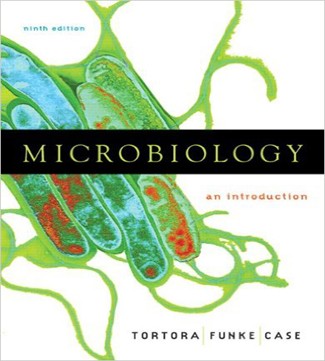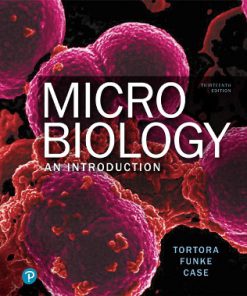Microbiology An Introduction 9th Edition Tortora Funke Case Test Bank
$35.00 Original price was: $35.00.$26.50Current price is: $26.50.
Microbiology An Introduction 9th Edition Tortora Funke Case Test Bank
This is completed downloadable of Microbiology An Introduction 9th Edition Tortora Funke Case Test Bank

Product Details:
ISBN 10: 0805347909
ISBN 13: 9780805347906
Author: Tortora Funke Case
With this Ninth Edition, the “Number One” best-selling non-majors microbiology text extends its trusted and reliable approach with improved disease chapters that feature efficient new “Disease in Focus” boxes, a thoroughly revised immunity chapter (17), new options for the Microbiology Place website/CD-Rom, and a new Media Manager instructor presentation package with 30 multi-step animations. Fundamentals of Microbiology: The Microbial World and You, Chemical Principles, Observing Microorganisms Through a Microscope, Functional Anatomy of Prokaryotic and Eukaryotic Cells, Microbial Metabolism, Microbial Growth, The Control of Microbial Growth, Microbial Genetics, Biotechnology and Recombinant DNA. A Survey of the Microbial World: Classification of Microorganisms, The Prokaryotes: Domains Bacteria and Archaea, The Eukaryotes: Fungi, Algae, Protozoa, and Helminths, Viruses, Viroids, and Prions. Interaction Between Microbe and Host: Principles of Disease and Epidemiology, Microbial Mechanisms of Pathogenicity, Innate Immunity: Nonspecific Defenses of the Host, Adaptive Immunity: Specific Defenses of the Host, Practical Applications of Immunology, Disorders Associated with the Immune System, Antimicrobial Drugs. Microorganisms and Human Disease: Microbial Diseases of the Skin and Eyes, Microbial Diseases of the Nervous System, Microbial Diseases of the Cardiovascular and Lymphatic Systems, Microbial Diseases of the Respiratory System, Microbial Diseases of the Digestive System, Microbial Diseases of the Urinary and Reproductive Systems. Environmental and Applied Microbiology: Environmental Microbiology, Applied and Industrial Microbiology. For all readers interested in microbiology concepts and applications.
Table of Content:
Chapter 1 The Microbial World and You
Objective Questions
1) Which of the following pairs is mismatched?
A) Ehrlich ? chemotherapy
B) Koch ? aseptic surgery
C) Pasteur ? proof of biogenesis
D) Jenner ? vaccination
Answer: B
Skill: Recall
2) Which of the following is a scientific name?
A) IGAS
B) Flesh-eating bacteria
C) Group A streptococcus
D) Streptococcus pyogenes
E) Streptococci
Answer: D
Skill: Analysis
3) Which of the following is not a domain in the three-domain system?
A) Animalia
B) Archaea
C) Bacteria
D) Eukarya
Answer: A
Skill: Recall
4) Which of the following is true about fungi?
A) All are prokaryotic.
B) All are multicellular.
C) All require organic material for growth.
D) All grow using sunlight and carbon dioxide.
E) All are plants.
Answer: C
Skill: Recall
1
2 Test Bank for Microbiology: An Introduction
5) Which of the following is not true about protozoa?
A) They have rigid cell walls.
B) They are classified by their method of locomotion.
C) All are unicellular.
D) All have complex cells.
E) All are eukaryotic.
Answer: A
Skill: Recall
6) Which of the following is true about viruses?
A) They are not composed of cells.
B) They cannot metabolize nutrients.
C) They cannot reproduce themselves.
D) They have DNA or RNA.
E) All of the above.
Answer: E
Skill: Recall
7) Which of the following is probably true about all the experiments that proved spontaneous
generation?
A) Air was lacking.
B) Too much heat was applied.
C) The food source could not support life.
D) Microorganisms were already present.
E) All of the above.
Answer: D
Skill: Analysis
8) Regarding Pasteur?s experiments with the S-neck flask, which of the following statements is
true?
A) There was air involved.
B) There was a food source involved.
C) Any possibility of contamination was removed.
D) All microorganisms were killed before beginning.
E) All of the above.
Answer: E
Skill: Understanding
CHAPTER 1 The Microbial World and You 3
9) Which of the following is true about insect control by microorganisms?
A) The insects develop resistance to the microorganisms.
B) The microorganisms are permanent in the environment.
C) The microorganisms are specific for the insect pest.
D) The microorganisms may cause disease in other animals.
E) This technique is just as dangerous as the use of chemical pesticides.
Answer: C
Skill: Analysis
10) Which of the following pairs is mismatched?
A) Hooke ? cell theory
B) van Leeuwenhoek ? germ theory
C) Lister ? aseptic surgery
D) Pasteur ? fermentation
E) None of the above
Answer: B
Skill: Recall
11) Who disproved the theory of spontaneous generation?
A) van Leeuwenhoek
B) Hooke
C) Pasteur
D) Koch
E) None of the above
Answer: C
Skill: Recall
12) Who observed cells in plant material?
A) van Leeuwenhoek
B) Hooke
C) Pasteur
D) Koch
E) None of the above
Answer: B
Skill: Recall
4 Test Bank for Microbiology: An Introduction
13) Who was the first to observe microorganisms with a microscope?
A) van Leeuwenhoek
B) Hooke
C) Pasteur
D) Koch
E) None of the above
Answer: A
Skill: Recall
14) Who proved that microorganisms cause disease?
A) van Leeuwenhoek
B) Hooke
C) Pasteur
D) Koch
E) None of the above
Answer: D
Skill: Recall
15) Which of the following is a scientific name?
A) Mycobacterium leprae
B) Hansen?s bacillus
C) Leprosy bacterium
D) Acid-fast bacteria
Answer: A
Skill: Recall
16) Classification of organisms in the three domains is based on
A) Cell wall.
B) Number of cells.
C) Cell type.
D) Nutritional type.
E) Nucleus.
Answer: C
Skill: Recall
People Also Search:
microbiology an introduction 9th edition tortora funke case
microbiology an introduction 9th edition tortora funke case download scribd
microbiology an introduction 9th edition tortora funke case test bank download pdf
You may also like…
Solution Manual












